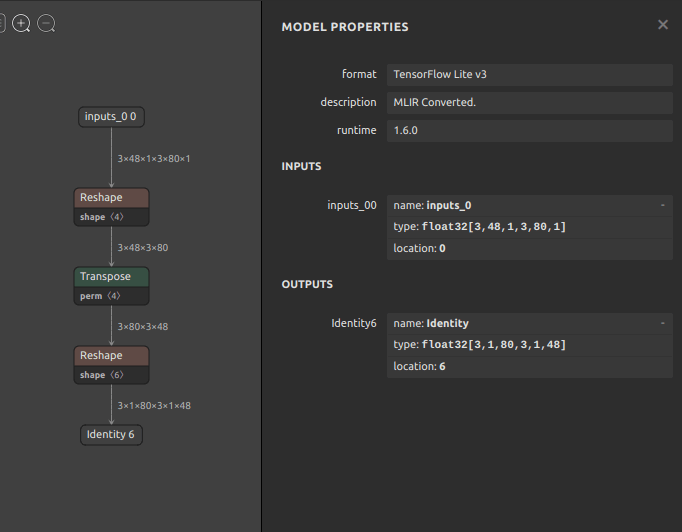Open3
TensorFlowの6D以上のTransposeがTensorFlow LiteでFlexTransposeになってしまう問題のワークアラウンド(5D以下の転置処理への強制置き換え)
- Numpy - 6次元のTransposeを4次元のTransposeに置き換えて処理する
import os
import math
import warnings
warnings.simplefilter(action='ignore', category=FutureWarning)
warnings.simplefilter(action='ignore', category=Warning)
warnings.simplefilter(action='ignore', category=DeprecationWarning)
warnings.simplefilter(action='ignore', category=FutureWarning)
warnings.simplefilter(action='ignore', category=RuntimeWarning)
import logging
import random
random.seed(0)
import numpy as np
np.random.seed(0)
os.environ['CUDA_VISIBLE_DEVICES'] = '-1'
os.environ['TF_CPP_MIN_LOG_LEVEL'] = '3'
import tensorflow as tf
tf.random.set_seed(0)
tf.keras.utils.set_random_seed(0)
tf.config.experimental.enable_op_determinism()
tf.get_logger().setLevel('INFO')
tf.autograph.set_verbosity(0)
tf.get_logger().setLevel(logging.FATAL)
###################################################################### パターン1
"""
original_shapes = [1,1,3,48,3,80]
target_perm = [0,1,2,4,3,5]
target_shapes = [1,1,3,3,48,80]
x_shape_one_dims = [0,1]
# 1. target_permから0と1を消す
remove_one_target_perm = [2,4,3,5]
# 2. 小さい数値から順番にゼロからの連番を付与する
replaced_remove_one_target_perm = [0,2,1,3]
# 3. original_shapes を squeeze する
squeezed_original_shapes = [3,48,3,80]
# 4. 3を2のpermで転置する
transposed_4d = [3,3,48,80]
# 5. x_shape_one_dimsの数値がtarget_permのどの位置にあったかを意識してReshapeする
shape_6d = transposed_4d.reshape(target_shapes)
# 6. Fin
shape_6d = [1,1,3,3,48,80]
"""
original_shapes = [1,1,3,48,3,80]
target_perm = [0,1,2,4,3,5]
target_shapes = [1,1,3,3,48,80]
# オリジナルデータ生成
x = np.arange(1, math.prod(original_shapes) + 1).reshape(original_shapes)
# オリジナルデータの形状把握
x_shape = x.shape
# 要素数が1の次元を取得
x_shape_one_dims = [
idx for idx in range(len(x_shape)) if x_shape[idx]==1
]
# 要素数が1の次元を削除
squeezed_original_x = np.squeeze(x, tuple(x_shape_one_dims))
# 要素数が1の次元を削除した形状を取得
squeezed_original_shapes = squeezed_original_x.shape
# オリジナルデータが5次元以上 なおかつ
# 要素数1の次元を削除したデータが4次元以下のときのみ特殊Transposeを実施
if len(x_shape) >= 5 and len(squeezed_original_shapes) <= 4:
remove_one_target_perm = [
idx for idx in target_perm if idx not in x_shape_one_dims
]
sorted_remove_one_target_perm = sorted(remove_one_target_perm)
replaced_remove_one_target_perm = [
sorted_remove_one_target_perm.index(idx) \
for idx in remove_one_target_perm
]
transposed_no_one_data = \
squeezed_original_x.transpose(replaced_remove_one_target_perm)
transposed_data = \
transposed_no_one_data.reshape(target_shapes)
print(f'**** Numpy pattern.1 check: {np.array_equal(transposed_data, x.transpose(target_perm))}')
###################################################################### パターン2
"""
original_shapes = [3,48,1,3,80,1]
target_perm = [0,2,1,3,5,4]
target_shapes = [3,1,48,3,1,80]
x_shape_one_dims = [2,5]
# 1. 2と5を消す
remove_one_target_perm = [0,1,3,4]
# 2. 小さい数値から順番にゼロからの連番を付与する
replaced_remove_one_target_perm = [0,1,2,3]
# 3. original_shapes を squeeze する
squeezed_original_shapes = [3,48,3,80]
# 4. 3を2のpermで転置する
transposed_4d = [3,48,3,80]
# 5. x_shape_one_dimsの数値がtarget_permのどの位置にあったかを意識してReshapeする
shape_6d = transposed_4d.reshape(target_shapes)
# 6. Fin
shape_6d = [3,1,48,3,1,80]
"""
original_shapes = [3,48,1,3,80,1]
target_perm = [0,2,1,3,5,4]
target_shapes = [3,1,48,3,1,80]
# オリジナルデータ生成
x = np.arange(1, math.prod(original_shapes) + 1).reshape(original_shapes)
# オリジナルデータの形状把握
x_shape = x.shape
# 要素数が1の次元を取得
x_shape_one_dims = [
idx for idx in range(len(x_shape)) if x_shape[idx]==1
]
# 要素数が1の次元を削除
squeezed_original_x = np.squeeze(x, tuple(x_shape_one_dims))
# 要素数が1の次元を削除した形状を取得
squeezed_original_shapes = squeezed_original_x.shape
# オリジナルデータが5次元以上 なおかつ
# 要素数1の次元を削除したデータが4次元以下のときのみ特殊Transposeを実施
if len(x_shape) >= 5 and len(squeezed_original_shapes) <= 4:
remove_one_target_perm = [
idx for idx in target_perm if idx not in x_shape_one_dims
]
sorted_remove_one_target_perm = sorted(remove_one_target_perm)
replaced_remove_one_target_perm = [
sorted_remove_one_target_perm.index(idx) \
for idx in remove_one_target_perm
]
transposed_no_one_data = \
squeezed_original_x.transpose(replaced_remove_one_target_perm)
transposed_data = \
transposed_no_one_data.reshape(target_shapes)
print(f'**** Numpy pattern.2 check: {np.array_equal(transposed_data, x.transpose(target_perm))}')
**** Numpy pattern.1 check: True
**** Numpy pattern.2 check: True
- TensorFlow - 6次元のTransposeを4次元のTransposeに置き換えて処理する
import os
import math
import warnings
warnings.simplefilter(action='ignore', category=FutureWarning)
warnings.simplefilter(action='ignore', category=Warning)
warnings.simplefilter(action='ignore', category=DeprecationWarning)
warnings.simplefilter(action='ignore', category=FutureWarning)
warnings.simplefilter(action='ignore', category=RuntimeWarning)
import logging
import random
random.seed(0)
import numpy as np
np.random.seed(0)
os.environ['CUDA_VISIBLE_DEVICES'] = '-1'
os.environ['TF_CPP_MIN_LOG_LEVEL'] = '3'
import tensorflow as tf
tf.random.set_seed(0)
tf.keras.utils.set_random_seed(0)
tf.config.experimental.enable_op_determinism()
tf.get_logger().setLevel('INFO')
tf.autograph.set_verbosity(0)
tf.get_logger().setLevel(logging.FATAL)
original_shapes = [3,48,1,3,80,1]
target_perm = [0,2,1,3,5,4]
target_shapes = [3,1,48,3,1,80]
# オリジナルデータ生成
npx = np.arange(1, math.prod(original_shapes) + 1).reshape(original_shapes)
x = tf.constant(npx)
# オリジナルデータの形状把握
x_shape = x.shape
# 要素数が1の次元を取得
x_shape_one_dims = [
idx for idx in range(len(x_shape)) \
if isinstance(x_shape[idx], int) and x_shape[idx]==1
]
# 要素数が1の次元を削除
squeezed_original_x = tf.squeeze(x, x_shape_one_dims)
# 要素数が1の次元を削除した形状を取得
squeezed_original_shapes = squeezed_original_x.shape
# オリジナルデータが5次元以上 なおかつ
# 要素数1の次元を削除したデータが4次元以下のときのみ特殊Transposeを実施
if len(x_shape) >= 5 and len(squeezed_original_shapes) <= 4:
remove_one_target_perm = [
idx for idx in target_perm if idx not in x_shape_one_dims
]
sorted_remove_one_target_perm = sorted(remove_one_target_perm)
replaced_remove_one_target_perm = [
sorted_remove_one_target_perm.index(idx) \
for idx in remove_one_target_perm
]
transposed_no_one_data = \
tf.transpose(
a=squeezed_original_x,
perm=replaced_remove_one_target_perm,
)
transposed_data = \
tf.reshape(
tensor=transposed_no_one_data,
shape=target_shapes,
)
print(f'**** TF check: {np.array_equal(transposed_data, tf.transpose(x, target_perm))}')
**** TF check: True
- TensorFlow Lite - 6次元のTransposeを4次元のTransposeに置き換えて処理し、
FlexTransposeの生成を抑止する
import os
import math
import warnings
warnings.simplefilter(action='ignore', category=FutureWarning)
warnings.simplefilter(action='ignore', category=Warning)
warnings.simplefilter(action='ignore', category=DeprecationWarning)
warnings.simplefilter(action='ignore', category=FutureWarning)
warnings.simplefilter(action='ignore', category=RuntimeWarning)
import logging
import random
random.seed(0)
import numpy as np
np.random.seed(0)
os.environ['CUDA_VISIBLE_DEVICES'] = '-1'
os.environ['TF_CPP_MIN_LOG_LEVEL'] = '3'
import tensorflow as tf
tf.random.set_seed(0)
tf.keras.utils.set_random_seed(0)
tf.config.experimental.enable_op_determinism()
tf.get_logger().setLevel('INFO')
tf.autograph.set_verbosity(0)
tf.get_logger().setLevel(logging.FATAL)
original_shapes = [3,48,1,3,80,1]
target_perm = [0,2,4,3,5,1]
target_shapes = [3,1,80,3,1,48]
inputs = tf.keras.Input(
shape=original_shapes[1:],
batch_size=original_shapes[0] \
if isinstance(original_shapes[0], int) else None,
dtype=tf.float32,
)
# オリジナルデータの形状把握
x_shape = inputs.shape
# 要素数が1の次元を取得
x_shape_one_dims = [
idx for idx in range(len(x_shape)) \
if isinstance(x_shape[idx], int) and x_shape[idx]==1
]
# 要素数が1の次元を削除
squeezed_original_x = tf.squeeze(inputs, x_shape_one_dims)
# 要素数が1の次元を削除した形状を取得
squeezed_original_shapes = squeezed_original_x.shape
# オリジナルデータが6次元以上 なおかつ
# 要素数1の次元を削除したデータが5次元以下のときのみ特殊Transposeを実施
if len(x_shape) >= 6 and len(squeezed_original_shapes) <= 5:
remove_one_target_perm = [
idx for idx in target_perm if idx not in x_shape_one_dims
]
sorted_remove_one_target_perm = sorted(remove_one_target_perm)
replaced_remove_one_target_perm = [
sorted_remove_one_target_perm.index(idx) \
for idx in remove_one_target_perm
]
transposed_no_one_data = \
tf.transpose(
a=squeezed_original_x,
perm=replaced_remove_one_target_perm,
)
transposed_data = \
tf.reshape(
tensor=transposed_no_one_data,
shape=target_shapes,
)
model = tf.keras.Model(inputs=inputs, outputs=transposed_data)
run_model = tf.function(lambda *inputs : model(inputs))
concrete_func = run_model.get_concrete_function(
*[tf.TensorSpec(tensor.shape, tensor.dtype) for tensor in model.inputs]
)
converter = tf.lite.TFLiteConverter.from_concrete_functions(
[concrete_func]
)
converter.target_spec.supported_ops = [
tf.lite.OpsSet.TFLITE_BUILTINS,
tf.lite.OpsSet.SELECT_TF_OPS,
]
tflite_model = converter.convert()
with open(f'model_float32.tflite', 'wb') as w:
w.write(tflite_model)
